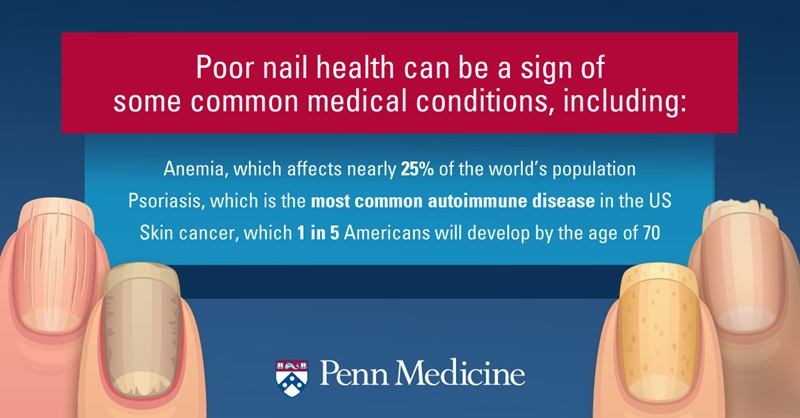Dark Spots on Nails That Wipe Off Then Come Back

It's easy to think your nails only serve a few purposes — to look good, to help you open stuff, or to scratch. You may buff, trim and paint them, but have you really looked at your nails — their color, thickness, or texture?
If you haven't, you might want to. The state of your nails can provide clues about various health problems — such as anemia and skin cancer. Taking a good look at your nails regularly is one more way to keep an eye on your health. If you see signs that something may be wrong, you'll know it's time to talk to your doctor.
Here are five signs to look for in your nails that can reveal important information about your health.
1. Yellowing or Thickening: Fungus
Your nails are supposed to be a nice shade of pink at the nail bed, turning to a clean white as they grow toward your fingertips. But if your nails appear yellow or thickened, you might have a fungus growing underneath.
A fungus is an infection that occurs because microscopic organisms are growing below your nails. While this usually won't cause any pain, it can be unsightly and cause embarrassment due to the appearance of your nails.
"A fungal infection can often be diagnosed through a simple physical exam. Depending on the severity of the infection, treatment usually consists of either an over-the-counter or prescription antifungal medication — topical or oral. Sometimes, in order to cure the fungus, you'll need to have the nail removed," explains Louise Vlachos, DO, physician at Penn Family and Internal Medicine Cherry Hill.
2. Brittle Nails: Anemia or Thyroid Disease
Aside from being annoying and sometimes unsightly, brittle nails can be a sign of something more. While brittleness can develop simply as a part of aging, if your nails seem to crack for no reason, this might be a sign of anemia.
Anemia is a condition where your body lacks enough hemoglobin, a protein that carries oxygen from your lungs to the rest of your body. While fatigue is the leading sign of anemia, this condition can also show itself through brittle or spoon-shaped nails — called koilonychia. A blood test can diagnose whether or not you have anemia.
The leading cause of anemia is iron-deficiency which can be easily treated by taking iron supplements and making diet changes to increase the amount of iron-rich foods you eat. Lean meats, beans, spinach, and raisins are excellent sources of iron.
Brittle nails can also be a sign of a thyroid disorder — meaning your thyroid makes too many or too few thyroid hormones. These tyrosine-based hormones help regulate your metabolism, which is how your body converts the foods you eat into energy.
If your nails split away from your nail bed, it might also signal thyroid disease.
Thyroid disease can be diagnosed with a blood test, and treatment may include taking certain vitamins or following a special diet, as well as undergoing hormone-replacement therapy or surgery in more severe cases.

3. Pitting and Grooving: Psoriasis or Alopecia Areata
Nails are generally supposed to be smooth. However, small cracks and depressions on your nail — known as "pitting" —can be a sign of psoriasis. Psoriasis is a skin disease that causes patches of skin that are itchy, sore, or red, and often have silvery scales. Your nails may also crumble, loosen, or even fall off.
Since hair and nails are so closely related, this might also be a sign of alopecia areata, which is a medical condition in which you lose patches of hair. There usually aren't any other symptoms of alopecia other than its impact on your hair and nails.
"Both conditions often require a physical exam to check for symptoms on other parts of your body," says Dr. Vlachos. She further explains, "treatments for psoriasis include phototherapy using ultraviolet lights, as well as topical or oral medications. Treating alopecia areata may involve receiving steroid injections, using topical medications, or undergoing ultraviolet light therapy."
4. Dark Lines: Melanoma
Even if you're diligent about checking your skin for dark spots and other signs of melanoma — a type of skin cancer — you might forget to check your nails. Melanoma can appear as a dark streak under your nail, distorting its color. Sometimes it will darken the cuticle surrounding your nail, too, which can be a sign of aggressive melanoma.
Melanoma is life-threatening, so it's important to get any dark lines under your nails checked immediately. Diagnosis may involve a physical exam and a biopsy, and treatment for melanoma can include surgery, chemotherapy, radiation therapy, immunotherapy, and targeted therapies.
5. White Lines: Kidney Disease or Liver Abnormalities
White lines underneath your nails may be a sign of kidney disease or liver problems. Both of these issues can discolor your nails because of a build-up of waste products in your body. Your kidneys and liver are supposed to rid your body of what it doesn't need, but when they aren't working properly, white lines may form under your nail bed.
Dr. Vlachos says, "a blood test can help determine if your liver and kidneys are functioning properly. Treatments for kidney or liver disorders may involve taking medications, undergoing dialysis to help remove excess waste from the body, or, in severe cases, receiving an organ transplant."
Do you have questions about your nail health? Request an appointment with a primary care doctor at Penn Medicine online or by calling 800-789-7366.
Dark Spots on Nails That Wipe Off Then Come Back
Source: https://www.pennmedicine.org/updates/blogs/health-and-wellness/2019/january/nail-health
0 Response to "Dark Spots on Nails That Wipe Off Then Come Back"
ارسال یک نظر